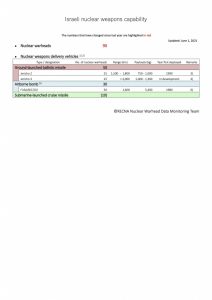Israeli nuclear weapons capability
【Overview】
Israel continues to possess nuclear weapons outside the NPT regime. Production of its nuclear arsenal likely began in the 1960s, Israel maintains its ‘ambiguity policy’, neither confirming nor denying that it has nuclear weapons.
Only limited information is available about Israel’s nuclear capability but it is believed to possess two types of ground-launched ballistic missiles and airborne bombs. Also, Israeli submarines operating in the high seas (see footnote 2) may carry cruise missiles (Kile, Shannon N. & Kristensen, Hans M. 2020).
As of early 2020, Israel has around 300 kg of high enriched uranium (HEU) and approximately 980 kg of weapons-grade plutonium (International Panel on Fissile Material 2021). To manufacture a nuclear bomb, depending on technical levels and other factors, it requires 12-18kg of HEU or 4-6kg of plutonium. Accordingly, Israel possesses nuclear fissile material equivalent to 180-270 warheads. With higher levels of technical sophistication, however, it is possible to obtain a bomb from 2-4kg plutonium (Union of Concerned Scientists 2009), in which case the same Israeli stockpile would suggest an arsenal of 262-515 warheads.
Kristensen and Korda, taking into consideration information on the amount of fissile material produced and potentially available nuclear-capable delivery vehicles, estimate that as of April 2021 Israel had a total of around 90 nuclear warheads (Kristensen, Hans M. & Korda, Matt 2021). This includes 10 SLCMs mentioned above. It should be noted that it appears Israel is separately storing its nuclear warheads and ground-launch missiles.
In the region, there have been calls for a weapons of mass destruction–free zone (WMDFZ) banning nuclear and other WMDs. Israel, however, has shown little enthusiasm for such a zone, claiming priority for regional peace and stability. When the first international conference for a WMDFZ met at United Nations Headquarters in November 2019, both Israel and the United States chose not to attend. It should be noted that there were plans for a second conference in November 2020 but these were postponed due to the Covid-19 pandemic.
【Notes】
1) The source for information on number of nuclear warheads, delivery range, payloads and year first deployed is Kile, Shannon N. & Kristensen, Hans M. 2020.
2) Israel is set to deploy six German-made Dolphin-class attack submarines. Five have already been turned over to Israel, and the sixth will be delivered in 2020 (NTI 2021). Out of five submarines, there are old Dolphin-class and the rest are improved version of Dolphin II-class (NTI2021).
3) Medium-range ballistic missile (MRBM), Solid-propellant. Two-stage. Road-Mobile. Expected to be replaced in phases by the Jericho 3 variant through 2026 (Missile Defense Project 2018-1).
4) Intermediate-range ballistic missile (IRBM), Solid-propellant. Three-stage. Road – & Rail-Mobile (Missile Defense Project 2018). The missile came into operation between 2011 and 2015 (Kile, Shannon N. & Kristensen, Hans M. 2020).
5) It is believed that part of the 25 F15 Strike Eagle aircrafts (called Lahm in Israel) carry out nuclear missions (Kile, Shannon N. & Kristensen, Hans M. 2020).
6) Israel possesses 98 of the aircraft. Part of these are thought to be on nuclear mission (Kile, Shannon N. & Kristensen, Hans M. 2020). It should be noted that Israel is pursuing a plan to replace its F16s with the latest U.S.-made F35 stealth fighters. A total of 50 of the F35 fighters are scheduled for receipt by 2024, and Israel is considering the purchase of a further 25 (Center for Arms Control and Non-Proliferation 2020).
【Source】
Center for Arms Control and Non-Proliferation 2020: “Israel’s Nuclear Inventory,” March 2020, https://armscontrolcenter.org/wp-content/uploads/2020/03/Israel.pdf (accessed April 15, 2021)
International Panel on Fissile Materials 2021: “Countries Israel,” 29 April 2021, http://fissilematerials.org/countries/israel.html (accessed May 10, 2021)
Kile, Shannon N. & Kristensen, Hans M. 2020: Israeli nuclear forces,” SIPRI Yearbook 2020 Armaments, Disarmament and International Security, Oxford University Press 2020, pp.375-377.
Kristensen, Hans M. & Korda, Matt 2021: “Status of World Nuclear Forces,” Federation of American Scientists. http://fas.org/issues/nuclear-weapons/status-world-nuclear-forces/ (accessed April 15, 2021)
Missile Defense Project 2018: “Jericho 2,” Missile Threat, Center for Strategic and International Studies, May 12, 2017, last modified June 15, 2018, https://missilethreat.csis.org/missile/jericho-2/ (accessed April 15, 2021)
NTI 2021: “Israel Submarine Capabilities, “ 18 February 2021, https://www.nti.org/analysis/articles/israel-submarine-capabilities/ (accessed April 15, 2021)
Union of Concerned Scientists 2009: “Weapon Materials Basics (2009),” http://www.ucsusa.org/nuclear-weapons/nuclear-terrorism/fissile-materials-basics#.WUTTElFpyM8 (accessed April 13, 2021)
©RECNA Nuclear Warhead Data Monitoring Team

















